S-Transform Based Traveling Wave Directional Pilot Protection for Hybrid LCC-MMC-HVDC Transmission Line
Abstract
:1. Introduction
2. S-Transform Principle
3. Typical Transmission System
3.1. Reflection and Refraction of TW
3.2. LCC-HVDC Rectifier Station
3.3. MMC-HVDC Inverter Station
4. Protection Principle
4.1. TW Propagation Characteristic in Hybrid LCC-MMC-HVDC Transmission System
4.2. Fault Direction Identification Algorithm
- If it is a forward fault for the relay, the phase angle difference between VTW and CTW is approximately equal to . In other words, the . Therefore,
- If it is a backward fault for the relay, the phase angle difference between VTW and CTW is approximately equal to 0. In other words, the . Therefore,
4.3. TW Protection Implementation
- (i)
- Start.
- (ii)
- Data sampling. The VTW and CTW data are sampled by a 1 MHz sampling rate, and the data window in this paper is 1 ms.
- (iii)
- Phase-mode transform. In order to adapt to different fault types, the paper adopts a positive sequence to calculatewhere and represent positive and zero sequence signals, respectively; and are positive and negative pole signals, respectively.
- (iv)
- Fault direction identification. Based on Section 4.2, the fault direction identification coefficient can be obtained. Afterwards, the fault direction is identified.
- (v)
- Send/receive. Two terminals exchange fault direction identification results, generally through an optical cable.
- (vi)
- Fault section identification. If the fault direction identification results of two terminals are both forward faults, the internal fault can be determined. Otherwise, an external fault can be determined.
- (vii)
- End.
5. Case Studies
5.1. Simulation Model
5.2. Typical Fault Simulation
5.2.1. The Proposed Protection Principle
5.2.2. The State-of-the-Art Work
5.3. Simulations under the Influence of Fault Location Issue
5.4. Simulations under the Influence of Fault Resistance Issue
6. Conclusions
- (i)
- The novel protection algorithm has good adaptability to a hybrid LCC-MMC-HVDC transmission line.
- (ii)
- The novel protection algorithm has the ability to identify fault section information (internal and external faults) correctly. Additionally, it is not affected by factors such as fault location, fault resistance and fault type.
- (iii)
- Light data exchange burden and no time synchronization pressure. Only fault direction identification coefficients are required to be transmitted via a communication channel (e.g., optical cable). In addition, no time synchronization system is required.
Author Contributions
Funding
Conflicts of Interest
Abbreviations
| LCC | Line commutated converter |
| MMC | Modular multilevel converter |
| VSC | Voltage source converter |
| HVDC | High-voltage direct current |
| TW | Traveling wave |
| IGBT | Insulated gate bipolar transistor |
| PWM | Pulse width modulation |
| VTW | Voltage traveling wave |
| CTW | Current traveling wave |
| PG | Positive pole to ground |
| NG | Negative pole to ground |
| PN | Positive pole to negative pole |
| CWT | Continuous wavelet transform |
| SFT | Short-time Fourier transform |
| SM | Submodule |
References
- Luo, S.B.; Gao, H.L.; Wang, D.; Zou, G.B. Non-unit transient based boundary protection for UHV transmission lines. Int. J. Electr. Power Energy Syst. 2018, 102, 349–363. [Google Scholar] [CrossRef]
- Zheng, J.C.; Wen, M.H.; Chen, Y.; Shao, X.N. A novel differential protection scheme for HVDC transmission lines. Int. J. Electr. Power Energy Syst. 2018, 94, 171–178. [Google Scholar] [CrossRef]
- Chen, G.; Hao, M.; Xu, Z.; Vaughan, A.; Cao, J.; Wang, H. Review of high voltage direct current cables. CSEE J. Power Energy Syst. 2015, 1, 9–21. [Google Scholar] [CrossRef]
- Zhang, Y.; Tai, N.; Xu, B. Fault analysis and traveling-wave protection scheme for bipolar HVDC lines. IEEE Trans. Power Deliv. 2012, 27, 1583–1591. [Google Scholar] [CrossRef]
- Huang, Q.; Zou, G.B.; Wei, X.Y.; Sun, C.J.; Gao, H.L. A non unit line protection scheme for MMC-based multi-terminal HVDC grid. Int. J. Electr. Power Energy Syst. 2019, 107, 1–9. [Google Scholar] [CrossRef]
- Xiao, H.Q.; Xu, Z.; Wang, S.J.; Liu, S.; Jiang, W. Control strategy for multi-infeed MMC-based HVDC system connected to weak grid. In Proceedings of the 2017 IEEE Power Energy Society General Meeting, Chicago, IL, USA, 16–20 July 2017; pp. 1–5. [Google Scholar]
- Jin, X.F.; Song, G.B.; Ma, Z.B. A novel pilot protection for VSC-HVDC transmission lines based on parameter identification. In Proceedings of the 12th IET International Conference on Developments in Power System Protection (DPSP 2014), Copenhagen, Denmark, 31 March–3 April 2014; pp. 1–6. [Google Scholar]
- An, W.; Wei, C.Z.; Mou, M.; Huang, W.F.; Jin, X.; Ye, H. Simulation and analysis of the control and protection performance for a multi terminal VSC-HVDC system. In Proceedings of the 13th International Conference on Development in Power System Protection 2016 (DPSP), Edinburgh, UK, 7–10 March 2016; pp. 1–4. [Google Scholar]
- Wang, D.; Hou, M.Q.; Gao, M.Y.; Qiao, F. Travelling wave directional pilot protection for hybrid HVDC transmission line. Int. J. Electr. Power Energy Syst. 2019, 107, 615–627. [Google Scholar] [CrossRef]
- Wang, Y.; Zhang, B.H. A novel hybrid directional comparison pilot protection scheme for the LCC-VSC hybrid hvdc transmission lines. In Proceedings of the 13th International Conference on Development in Power System Protection 2016 (DPSP), Edinburgh, UK, 7–10 March 2016; pp. 1–6. [Google Scholar]
- Tang, G.; Xu, Z. A LCC and MMC hybrid HVDC topology with DC line fault clearance capability. Int. J. Electr. Power Energy Syst. 2014, 62, 419–428. [Google Scholar] [CrossRef]
- Zheng, X.D.; Tai, N.L.; Yang, G.L.; Ding, H.Y. A transient protection scheme for HVDC transmission line. IEEE Trans. Power Deliv. 2012, 27, 718–724. [Google Scholar] [CrossRef]
- Gijare, P.P.; Tade, S.V. Protection of permanent faults on DC overhead lines in hybrid converter based HVDC system. In Proceedings of the 2015 International Conference on Energy Systems and Applications, Pune, India, 30 October–1 November 2015; pp. 302–305. [Google Scholar]
- Wang, Y.T.; Zhang, B.H. Study on the transmission line boundary characteristics of the hybrid HVDC system. In Proceedings of the 2016 IEEE PES Asia Pacific Power and Energy Engineering Conference (APPEEC), Xi’an, China, 25–28 October 2016; pp. 1311–1315. [Google Scholar]
- Deng, F.; Li, X.R.; Zeng, X.J. Single-ended travelling wave protection algorithm based on full waveform in the time and frequency domains. IET Gener. Transm. Distrib. 2018, 12, 3680–3691. [Google Scholar] [CrossRef]
- Zou, G.B.; Huang, Q.; Song, S.L.; Tong, B.B.; Gao, H.L. Novel transient-energy-based directional pilot protection method for HVDC line. Prot. Control. Mod. Power Syst. 2017, 2, 159–168. [Google Scholar] [CrossRef]
- Li, Z.; Zou, G.B.; Du, T.; Yang, W.J. S-transform based pilot protection method for hvdc transmission lines. In Proceedings of the 2015 5th International Conference on Electric Utility Deregulation and Restructuring and Power Technologies (DRPT), Changsha, China, 26–29 November 2015; pp. 1667–1672. [Google Scholar]
- Wang, D.; Gao, H.L.; Luo, S.B.; Zou, G.B. Travelling wave pilot protection for LCC-HVDC transmission lines based on electronic transformers’ differential output characteristic. Int. J. Ofelectrical Power Energy Syst. 2017, 93, 283–290. [Google Scholar] [CrossRef]
- Krishna, T.N.V.; Sathishkumar, P.; Himasree, P.; Punnoose, D.; Raghavendra, K.V.G.; Himanshu; Naresh, B.; Rana, R.A.; Kim, H.J. 4T Analog MOS Control-High Voltage High Frequency (HVHF) Plasma Switching Power Supply for Water Purification in Industrial Applications. Electronics 2018, 7, 245. [Google Scholar] [CrossRef] [Green Version]
- Krishna, T.N.V.; Himasree, P.; Rao, S.S.; Kumar, Y.A.; Kundakarla, N.B.; Kim, H.J. Design and Devel-opment of a Digital Controlled Dielectric Barrier Discharge (DBD) AC Power Supply for Ozone Generation. J. Sci. Ind. Res. 2020, 79, 1057–1068. [Google Scholar]
- Wang, D.; Gao, H.L.; Luo, S.B.; Zou, G.B. Ultra-high-speed travelling wave protection of transmission line using polarity comparison principle based on empirical mode decomposition. Math. Probl. Eng. 2015, 2015, 1–9. [Google Scholar] [CrossRef]
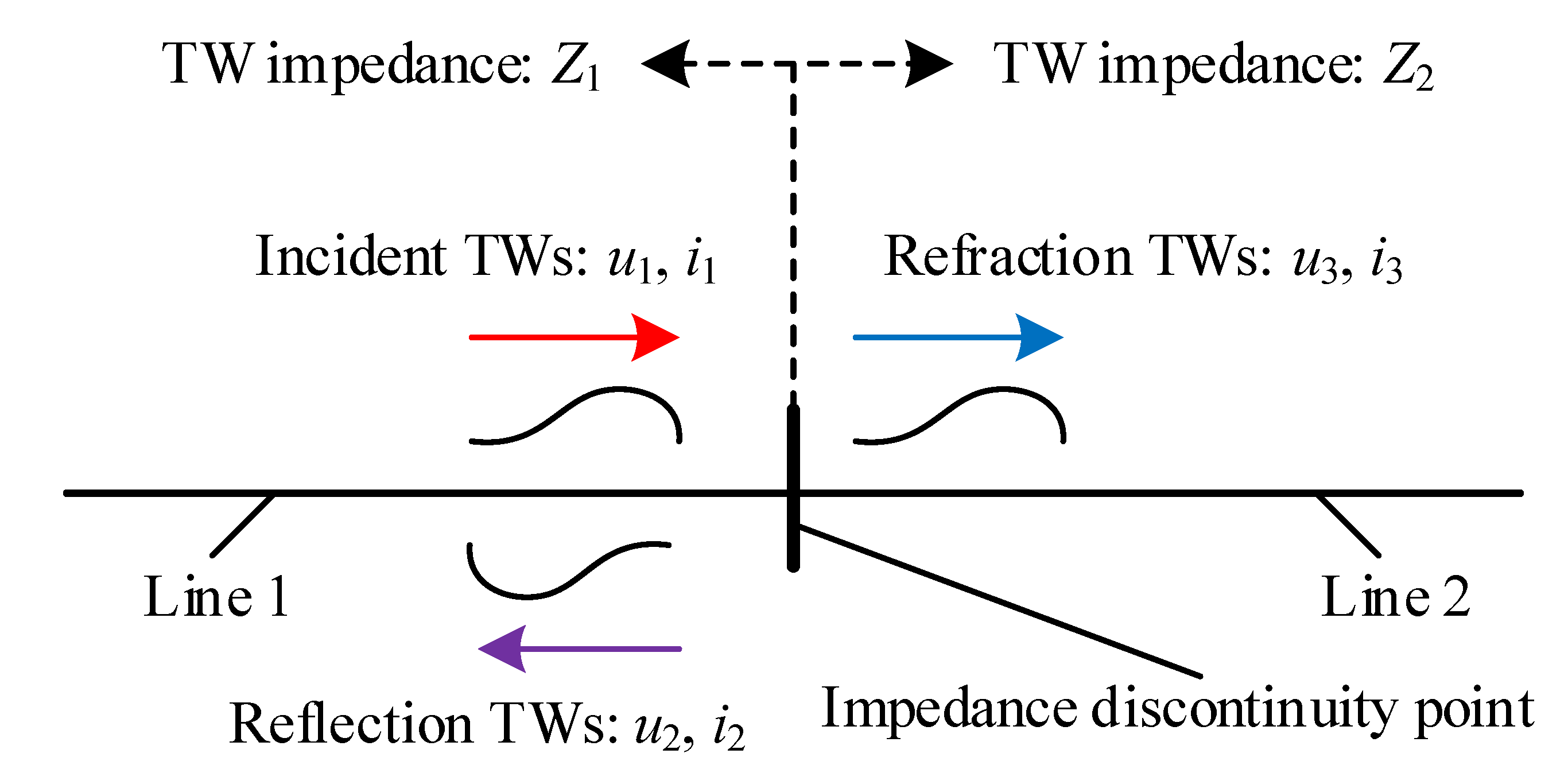
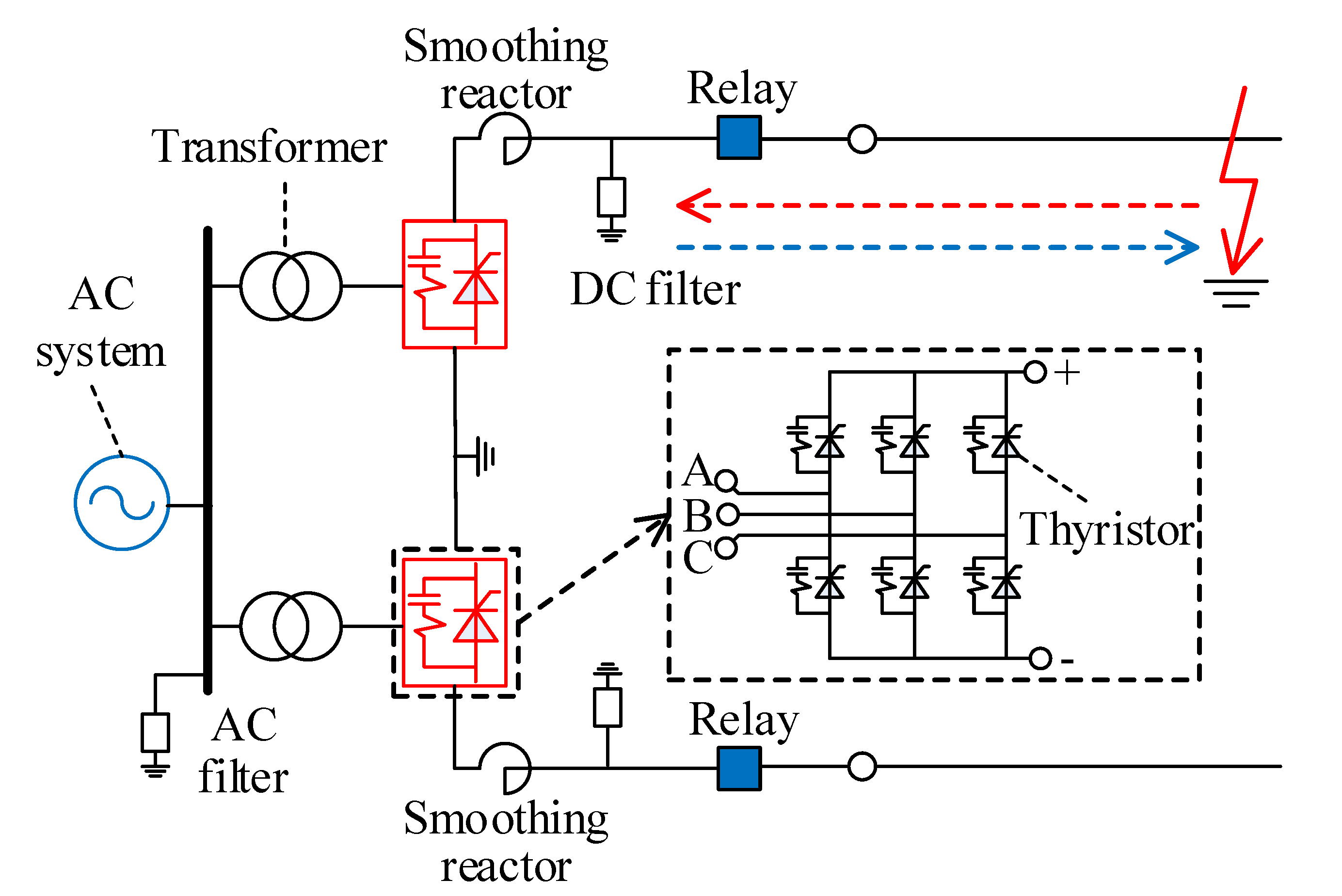

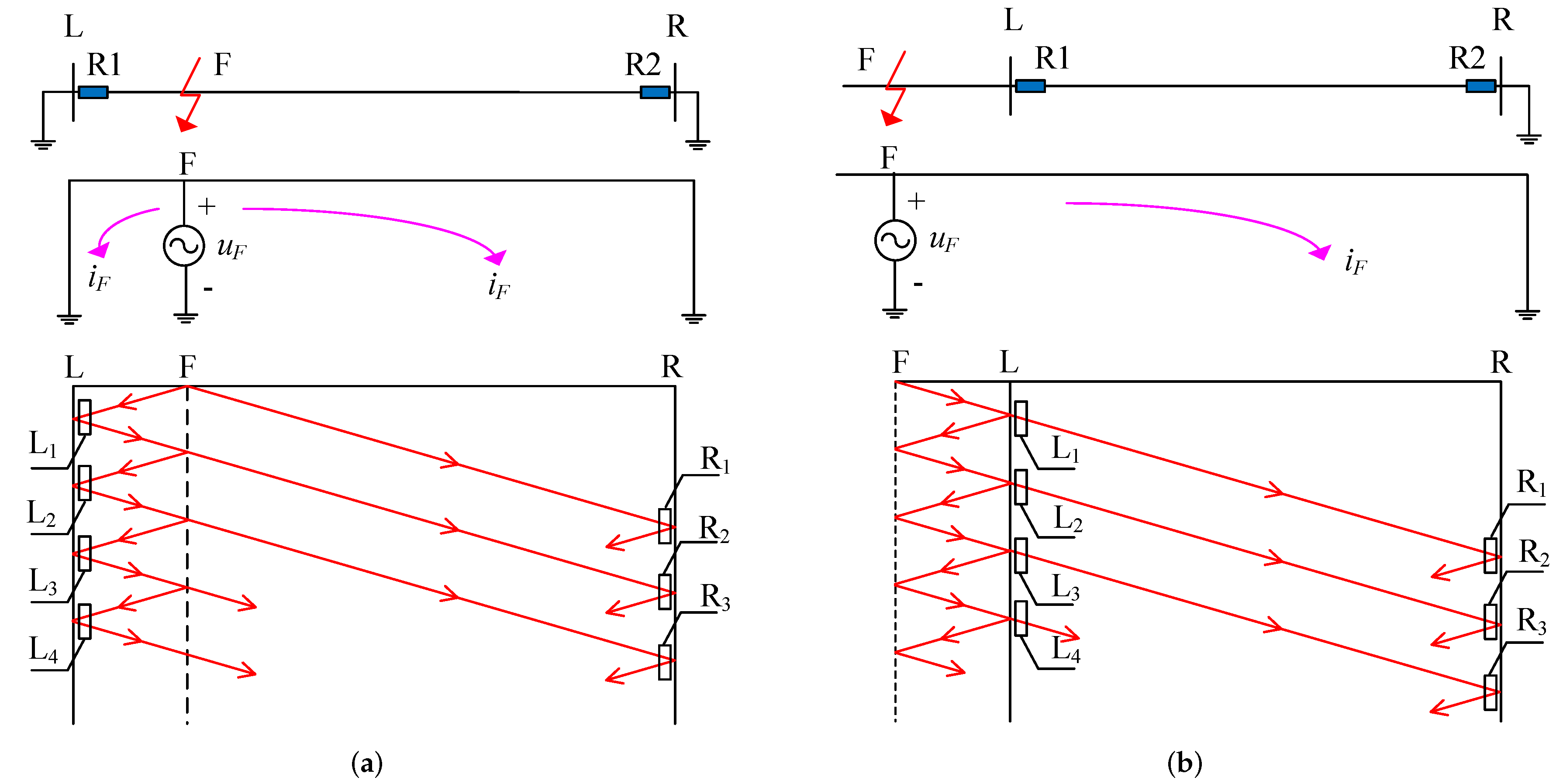
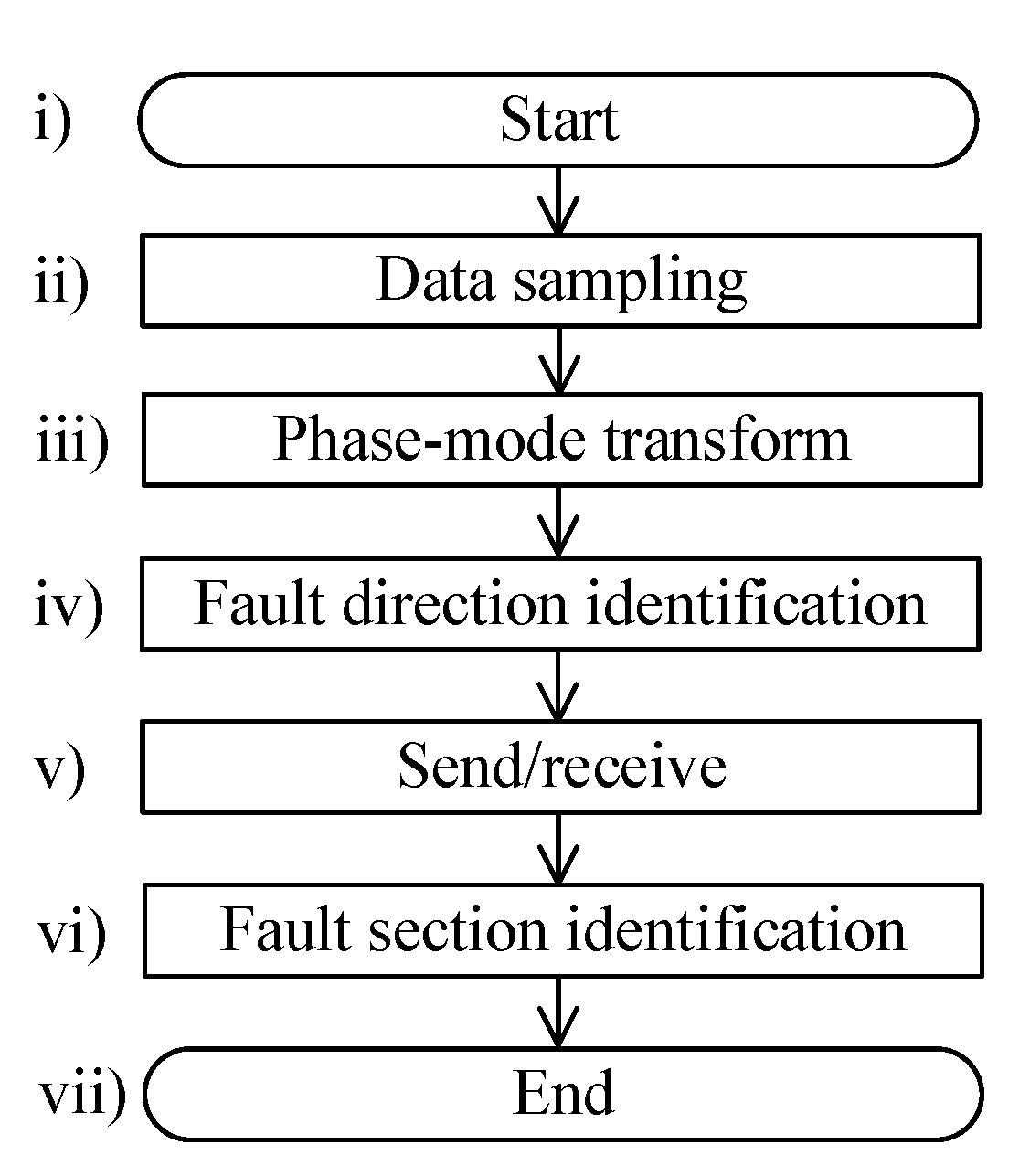
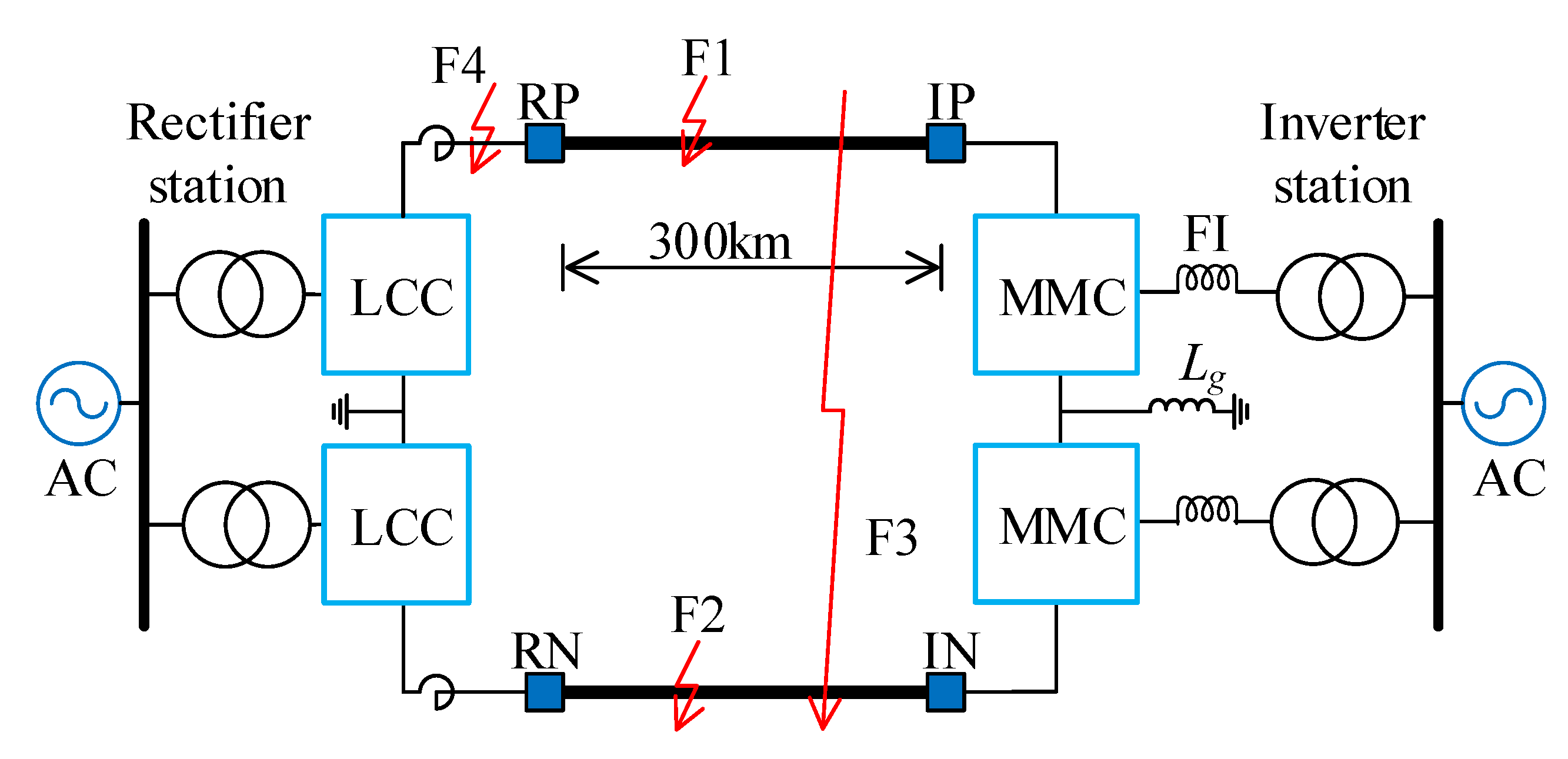


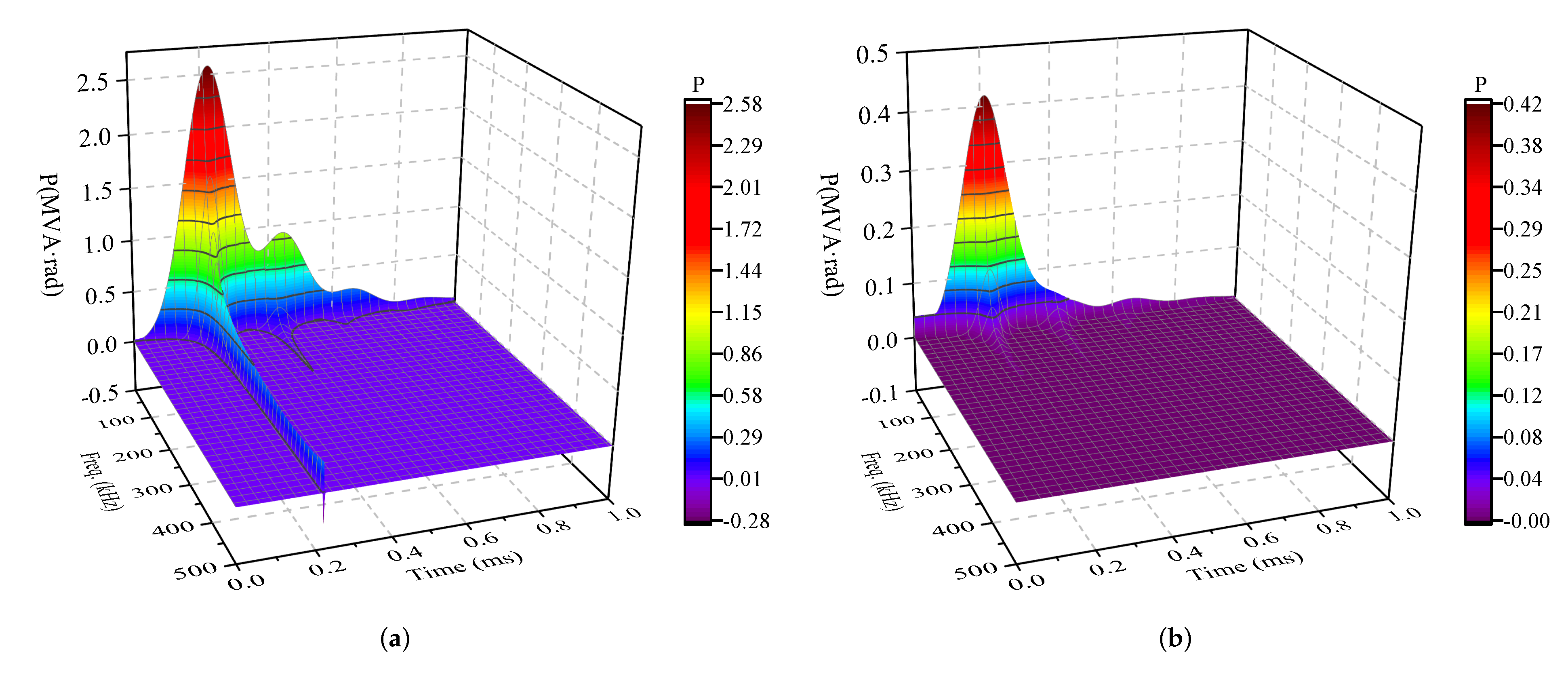
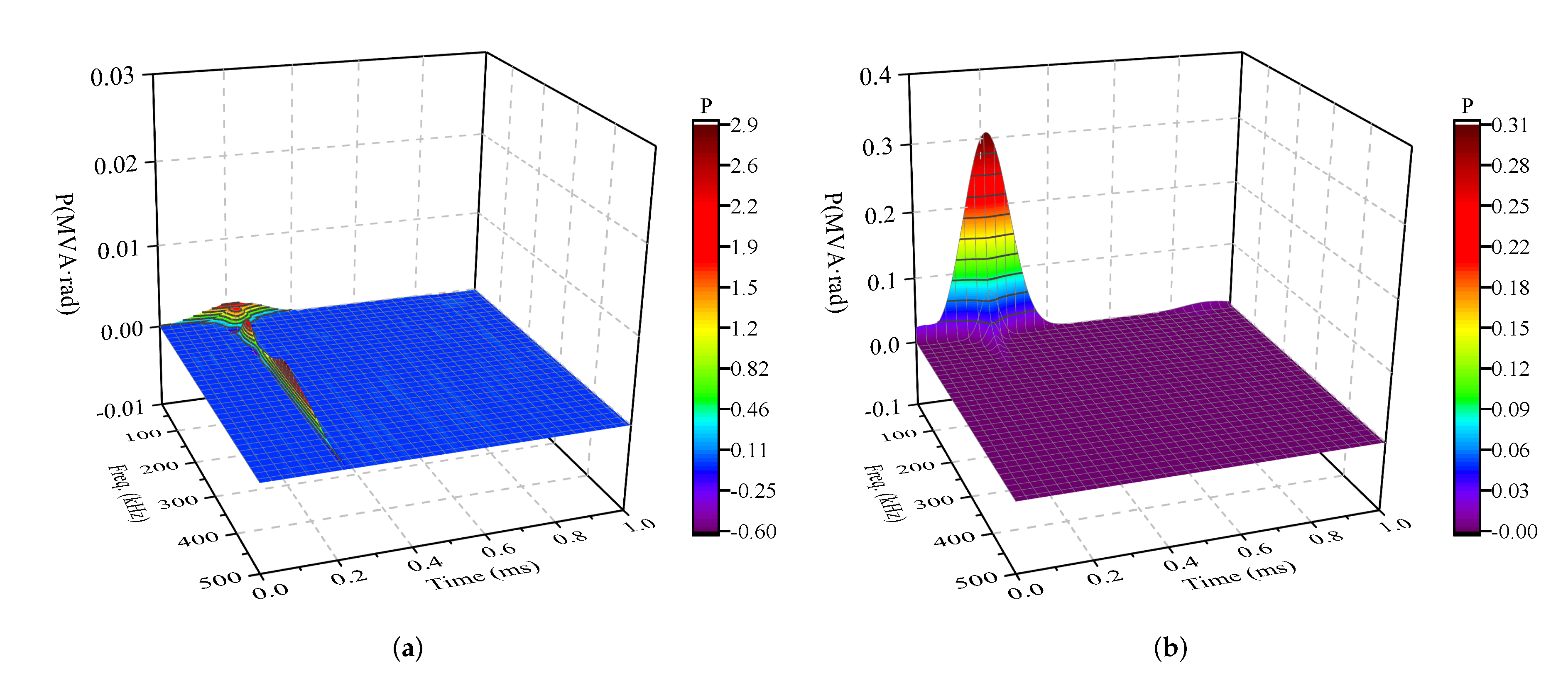



| No. | Rectifier Side | No. | Inverter Side | ||||
|---|---|---|---|---|---|---|---|
| ⋯ | ⋯ | ⋯ | ⋯ | ⋯ | ⋯ | ||
| No. | Rectifier Side | No. | Inverter Side | ||||
|---|---|---|---|---|---|---|---|
| 0 | |||||||
| 0 | |||||||
| 0 | |||||||
| ⋯ | ⋯ | ⋯ | ⋯ | ⋯ | ⋯ | ||
Publisher’s Note: MDPI stays neutral with regard to jurisdictional claims in published maps and institutional affiliations. |
© 2022 by the authors. Licensee MDPI, Basel, Switzerland. This article is an open access article distributed under the terms and conditions of the Creative Commons Attribution (CC BY) license (https://creativecommons.org/licenses/by/4.0/).
Share and Cite
Zhang, W.; Wang, D. S-Transform Based Traveling Wave Directional Pilot Protection for Hybrid LCC-MMC-HVDC Transmission Line. Energies 2022, 15, 4802. https://doi.org/10.3390/en15134802
Zhang W, Wang D. S-Transform Based Traveling Wave Directional Pilot Protection for Hybrid LCC-MMC-HVDC Transmission Line. Energies. 2022; 15(13):4802. https://doi.org/10.3390/en15134802
Chicago/Turabian StyleZhang, Wei, and Dong Wang. 2022. "S-Transform Based Traveling Wave Directional Pilot Protection for Hybrid LCC-MMC-HVDC Transmission Line" Energies 15, no. 13: 4802. https://doi.org/10.3390/en15134802






